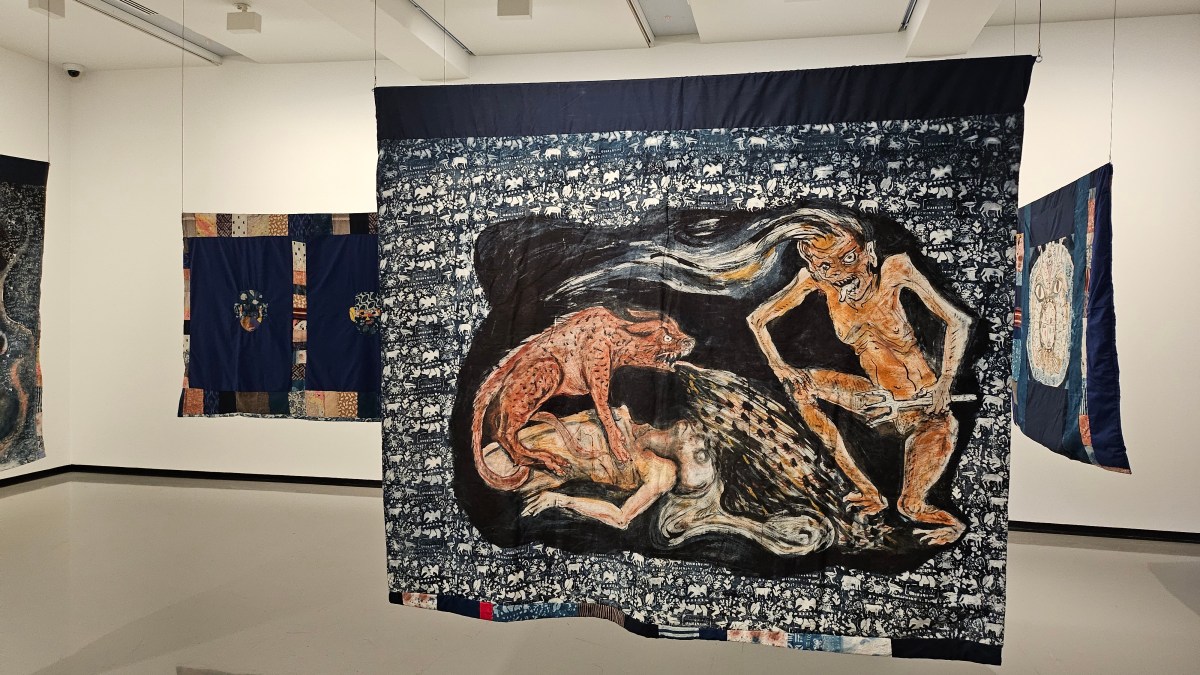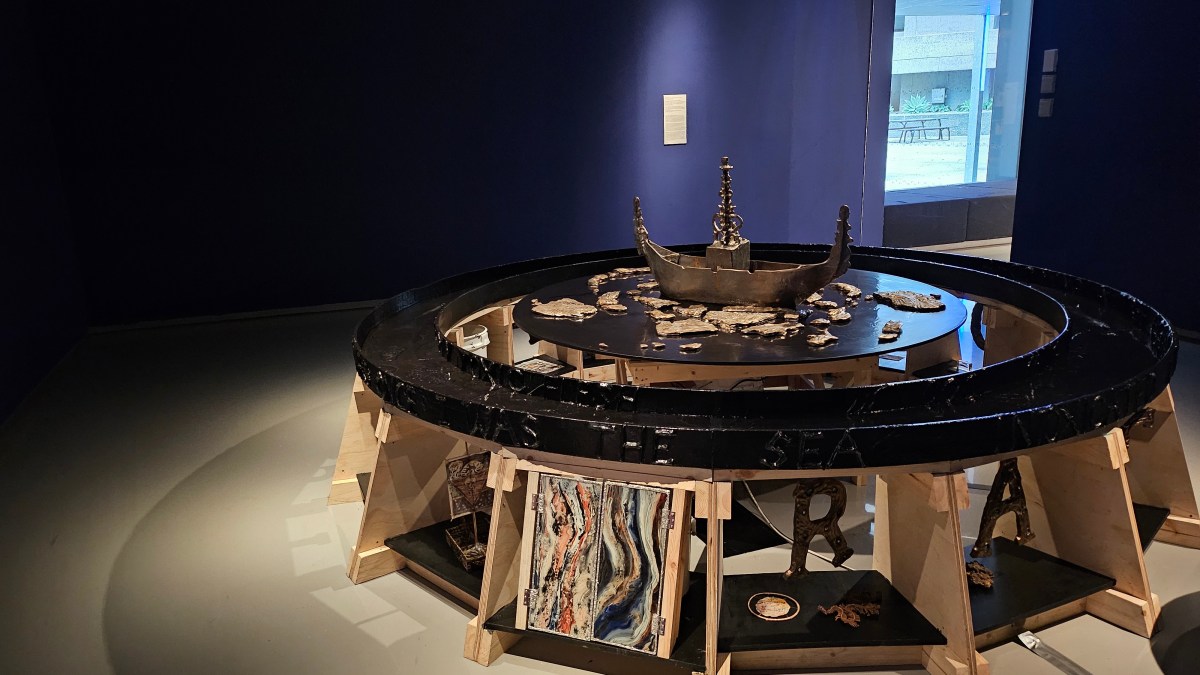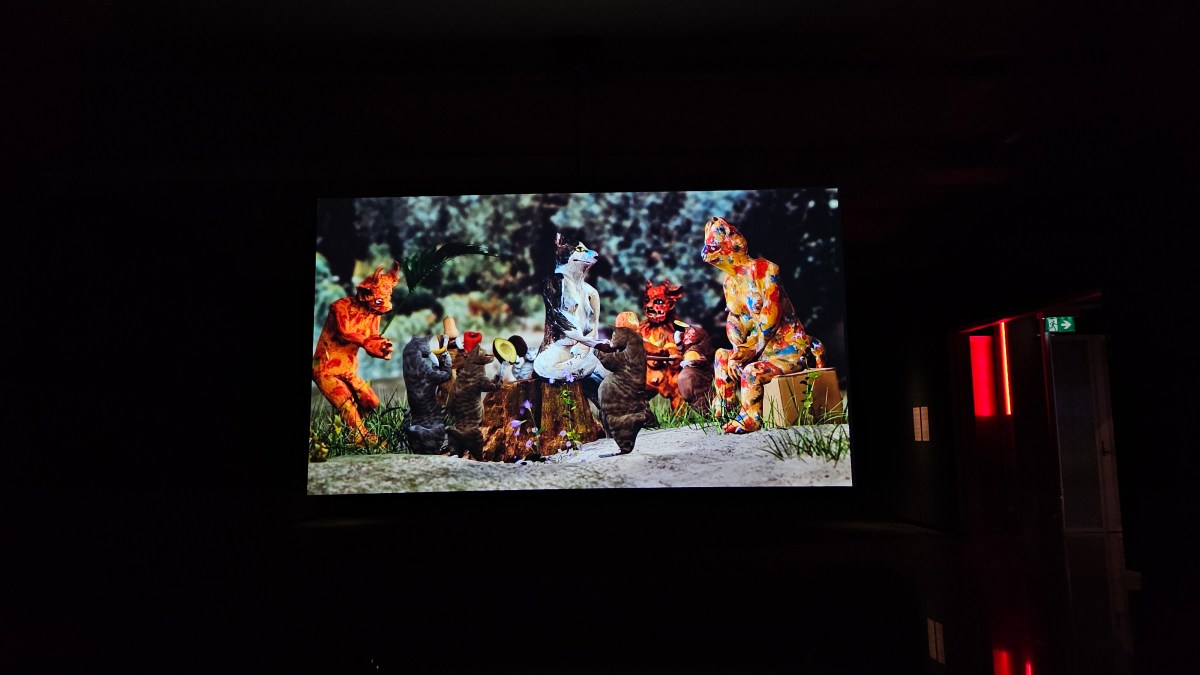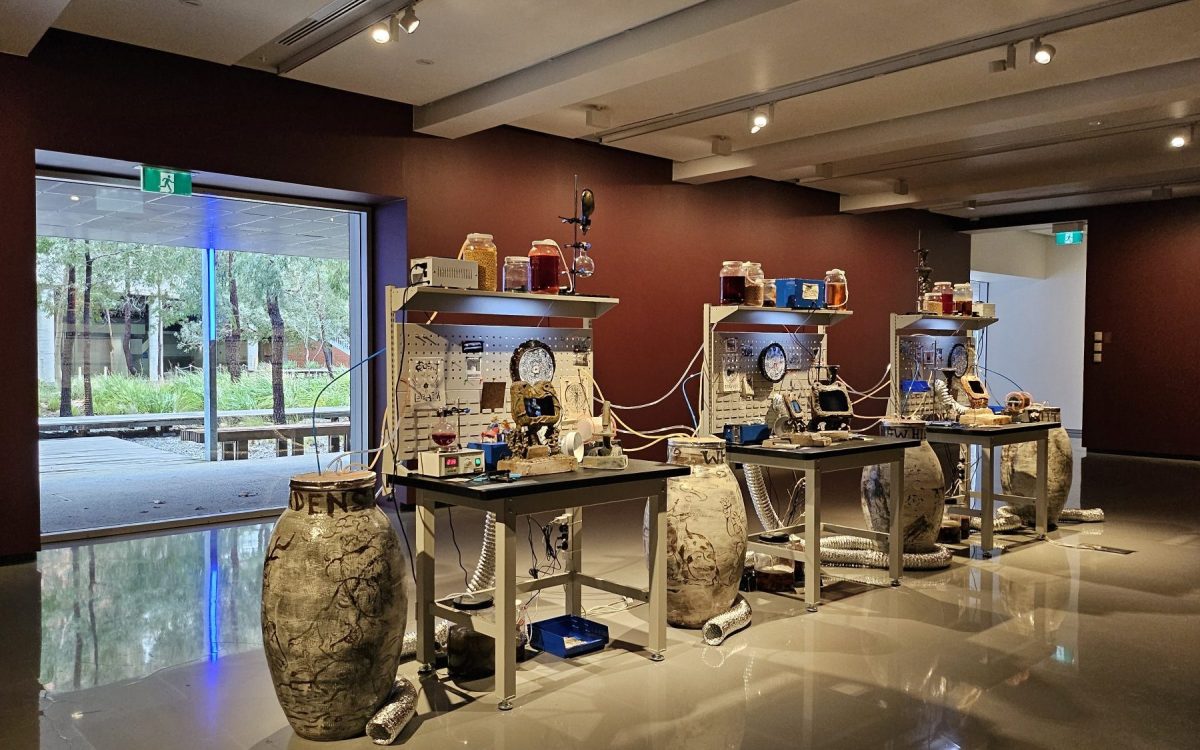Chinese American artist Candice Lin’s first institutional show in Australia, The Sex Life of Stone, takes its cue from an essay by Jeffery J Cohen on the ‘ecology of the inhuman’. The exhibition is a skin-crawling dive into the uncomfortable realm of human and non-human animal intimacy against an undertone of forbidden love in our capitalist money-driven era.
The title of the show presents a juxtaposition. While stones have been animated by humans for millennia – through drawings, inscriptions and googly eyes – they perhaps have the least desire or need to procreate. What we inscribe onto stone is a projection of our desires and The Sex Life of Stone reveals how our relationship with the world can be filtered and understood through the inhuman, such as minerals.
The exhibition forms a narrative allure emblematic of the meticulous artist and is presented like the laboratory of a mad scientist. Her test site, Lithium Sex Demons in the Factory (2023) alters the pristine space of Monash University Museum of Art (MUMA) into a factory harbouring toxic chemicals and a foreboding sense of dark humour. Each work desk is filled with experimental devices and jars of unidentified liquid, alongside several small video screens displaying visual storytelling that moves between the aesthetics of folklore to early home-brewed CGI.
What is missing are the labourers of Lin’s toxic factory, and yet their presence lingers through scribbles on Post-it notes and cynical memes on pinboards. Physical exertion on the job and the lack of mental stimulation mutate into wild fantasies on the video screens. In one, crude beasts smoke on used tampons in the toilet cubicle, referencing Lin’s short story that underpins the installation, ‘My Life as a Lithium Sex Demon‘.
In the story, demons use lithium like a time-travel device to enter the human world and the protagonist seeks to return from the dead to a loved one who worked in the factory.
Lithium Sex Demons in the Factory presents a love story of desperate devices, one that hopelessly attempts to transcend the divide between life and death, romance and reality. It’s a playground of despair for the overworked.
Here, Lin has worked with MUMA’s Senior Curator, Pip Wallis, to enclose the viewer in the artist’s surreal world, showcasing a depth in both artistic and curatorial thinking. Small copper sheets embossed with demonic figures and miniature sculptural arrangements that appear almost ritualistic are displayed at odd locations, purposefully positioned like a form of spatial intervention that infiltrates the gallery with their ghostly presence.
Traditional Chinese ceremonial wares (like horn-shaped cups) are paired with sterile lab equipment, while Lin toys with the alchemical properties of liquids and matter in strategically intentional, but deceptively incidental ways.
The depressing psyche of Chinese factory workers has been explored in other works that recently toured to Australia. In Njo Kong Kie’s Adelaide stage performance, I Swallowed a Moon Made of Iron, the poetry of Foxconn worker Xu Lizhi revealed the gloomy hopelessness of his situation. By contrast, Lin’s approach of utilising fantasy and speculative futures has the power to intrigue and captivate by transcending people beyond the everyday.
The exhibition also includes a selection of seven paintings in MUMA’s final gallery space tied to the installation. Each depicts a Lithium Sex Demon Scene from Lin’s fictional universe, which builds upon folklore, historical horror and demonic urban tales set in factory settings.

While not specifically created for the Australian context, Lin’s works evoke reflections on how harnessing a single mineral can establish a political and economic grip on the world. China remains a global giant in lithium, driven by its essential use in electronic vehicles and smartphones. In the US’s tug-of-war to gain higher ground on the resource, it has looked to Western Australia’s lithium supply with China quick to follow suit.
An Australian co-commissioned work, I Breathe through My Anus (Night Stone) (2024) tackles colonialism and imperialism from a similar angle while showcasing the artist’s consistent ability to engage with a global outlook while being invested in a local context.
A ceramic boat glazed in oily black pigment turns slowly on a circular timber structure that channels water around its circumference, accompanied by an almost tribal soundtrack that heightens a sense of voyage and mystique.
The title references a biological characteristic of the sea cucumber (trepang), which was once a trade commodity between the Anindilyakwa people of Groote Eylandt, East Arnhem Land in the Northern Territory and Indonesian Makassar traders. This history traces back to the 1700s and First Nations bark paintings were found depicting Makassan boats (praus) using manganese ore as pigment. Ironically, this was what alerted colonisers to the mineral’s rich existence in the region and thus began their extractive mission.
Groote Eylandt is still one of the world’s largest sources of manganese today, extracted by global mining companies and exported for use in the production of steel and lithium batteries, including in China.
While Australia prides itself on its natural resources, the mines have had destructive impacts on the health and cognitive wellbeing of nearby First Nations communities and continue to exploit unceded traditional lands.

Lin’s world-building in The Sex Life of Stone extends to the exhibition booklet, which presents a dystopian science-fiction story written by Canadian novelist Larissa Lai, who draws together topics of race, sex, identity, feminism and Chinese mythology. In ‘Nukes and Cukes’, a daughter cloned from her mother – the last remaining genetic artist – talks about their trepang farm in a world where the marine animals have become extinct due to overfishing.
We learn that trepang farming is a tough job in a scenario where human DNA has been genetically modified with that of the trepang, making them more like kin than a commodity. Harvesting trepang takes an emotional toll and is an ethical dilemma necessary for survival.
The second-person narrative initially positions the reader as an innocent visitor, but its ending suggests we are in fact a greedy Chinese businessperson who has the intention of overthrowing the Crone for her profits.
While ‘Nukes and Cukes’ is set in a fictional world, existing practices of animal husbandry and ownership are questioned throughout Lin’s exhibition.
The Animal Husband (2024), featuring the narratives of Lin and her cat, Roger, unravels pet ownership as a deeply unnatural, if not perverse, relationship – a trade-off between survival and companionship muddled in the name of love. Interweaving the sexually-charged audio narratives are anecdotes and legal cases exploring the ethics of animal husbandry.
Roger draws out the bizarre and horrifying history of Thomas Granger (c. 1625-1642), the first juvenile executed in what is now the US for bestiality. ‘A cowe [sic], two goats, five sheep, two calves and a turkey’ is repeated through Roger’s voice in the gallery, reciting the boy’s ‘crime against nature’.
The dialogue between Lin and Roger also suggests animal-human relationships to be anything but straightforward. Furthermore, the current legal framework around bestiality is complicated by common agricultural practices such as artificial insemination.
Notably, although Lin is unafraid to work with taboos and challenge norms, it’s not her intention to elicit horror or disgust. Instead, the artist comes off as explicit but honest, supporting what could easily be seen as “shock factor” with real-life underpinnings while using visual devices to lock a viewer’s gaze.
Displaying on the flip side of The Animal Husband is The Blueness (2021), an earlier video work narrated from the perspective of Roger’s truth-seeking, death-fearing uncle. It’s an engaging counterpart to Roger’s story, exemplifying the autonomy of a free-roaming feline faced with the precarity of civilisation.

In the same space as the two videos, fleshy adornments hang from the ceiling attached to three metal collars – their imagery barely visible in the low lighting to allow for discovery and close inspection. They portray human-animal affection in ways that combine fetishisation with the uncanny.
One depicts a wolf-dog creature poking its tongue into the mouth of a human, flipping the paternal act of feeding from “owner” to “pet”.
Read: Exhibition review: (SC)OOT(ER)ING around, TarraWarra Museum of Art
In the artist’s words, what she is trying to establish is ‘a non-alienated relationship to the world’. As human and animal kinship becomes increasingly complex with the development of genetic engineering, the questions raised in Lin’s practice have applicable relevance in a society rapidly shaped by science and technology.
For example, how will the transplant of pig organs to humans (xenotransplantation) impact human-to-non-human animal relationships? It calls into question ideas around care, exploitation and kinship. Countless literature, movies and art have told us that those expecting a purely clinical outcome without examining the social and ethical questions are in for a nasty surprise.
Candice Lin: The Sex Life of Stone is on view at MUMA until 7 September, curated by Pip Wallis; free.





